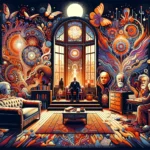10 Times Carl Sagan Changed the Way We Looked at the Universe
Carl Sagan, an astronomer, cosmologist, astrophysicist, and a masterful science communicator, has left an indelible mark on how we understand our universe. Known not just for his groundbreaking research, but for his ability to convey the most complex scientific concepts with simplicity and awe, Sagan brought the universe into our living rooms. Through his books, television series, and public lectures, he transformed the public’s understanding of science and our place in the cosmos. This blog post celebrates ten pivotal moments in which Carl Sagan fundamentally shifted our perspective on the universe.
1. The Pale Blue Dot
One of Sagan’s most profound contributions to our perspective on the universe came through the “Pale Blue Dot” photograph taken by Voyager 1 in 1990. Sagan, who advocated for the photo to be taken from about 6 billion kilometers away, provided a commentary that has since become iconic. He described Earth as a “pale blue dot” in the vast cosmos, emphasizing our planet’s fragility and the need for humility and stewardship. This perspective has not only enriched public understanding but has also influenced discussions on environmental responsibility and the human condition in the cosmos.
2. “Cosmos: A Personal Voyage”
In 1980, Carl Sagan co-created and hosted the television series “Cosmos: A Personal Voyage,” which became one of the most widely watched series in the history of American public television. The series, blending science facts with a narrative almost poetic in its delivery, reached millions of viewers worldwide.
Sagan’s ability to connect cosmic phenomena with earthly significance made astronomy accessible and intriguing to the general public. His explanations of complex topics, such as the fourth dimension, evolution, and the history of the universe, not only educated but also inspired a generation to look at science as a vital part of the human experience.
3. The Cosmic Calendar
Carl Sagan introduced the concept of the Cosmic Calendar in the original “Cosmos” series, a method for visualizing the chronology of the universe by scaling its 13.8-billion-year history down to a single year. In this calendar, each ‘month’ represents about a billion years, each ‘day’ about 40 million years, and each ‘second’ about 500 years. This visualization helps people grasp the immensity of cosmic time and the relatively brief moment that human history occupies within it. By compressing the vast history of the universe into a familiar, human-scaled framework, Sagan made the abstract concept of geological and cosmic time comprehensible and engaging.
4. Promotion of SETI (Search for Extraterrestrial Intelligence)
Carl Sagan was a staunch advocate for the scientific search for extraterrestrial life. He was instrumental in the formulation of the Drake Equation, which estimates the number of communicative civilizations in the cosmos. His enthusiasm for SETI efforts encouraged broader public interest and support for projects aimed at detecting signals from alien civilizations. Sagan’s work popularized the notion that we might not be alone in the universe, expanding our view of our place in the cosmos and prompting philosophical and scientific discussions about the nature of life and intelligence beyond Earth.
5. Nuclear Winter Theory
Alongside his contributions to understanding the cosmos, Sagan also co-authored the “nuclear winter” theory, which predicted severe global climatic cooling as a result of nuclear war. This concept had a profound impact on how the public and policymakers viewed the potential consequences of nuclear conflict. By using models similar to those used in studying planetary climates, including the atmospheres of other planets, Sagan and his colleagues showed that a nuclear war could lead to catastrophic changes in the Earth’s climate. This work bridged planetary science and public policy, highlighting humanity’s ability to alter its environment drastically and the necessity for international peace and cooperation.
6. “Contact” and the Humanization of Science
Carl Sagan’s novel “Contact,” later adapted into a major motion picture, explores the implications of first contact with an extraterrestrial civilization through the eyes of Dr. Eleanor Arroway, a character inspired by his passion for science and the human experience.
In “Contact,” Sagan illustrates not just the mechanics of interstellar communication but delves deeply into the philosophical and societal impacts such an event would have. This work has had a profound influence on public perceptions of scientists and the scientific process, portraying them as deeply human, driven by curiosity, fear, and wonder—just like the rest of us. “Contact” made the idea of alien life less about science fiction and more about a possible future event, prompting audiences to consider how we might react to the discovery of life beyond Earth.
7. Education and Advocacy for Scientific Skepticism
Carl Sagan was a vocal proponent of scientific skepticism and the scientific method. His book “The Demon-Haunted World: Science as a Candle in the Dark” advocates for a scientific approach to understanding the world, criticizing pseudoscience and superstition. Through this work, he sought to equip people with what he termed a “baloney detection kit,” a set of cognitive tools to critically evaluate arguments and claims, particularly in the realm of purportedly scientific discussions. This push for critical thinking and skepticism has not only changed how individuals assess claims and evidence but has also fostered a more informed public discourse on science.
8. Advocacy for Space Exploration
Carl Sagan was not only a communicator of science; he was also an ardent advocate for space exploration. His testimony before Congress in the 1970s and 1980s helped shape the U.S. space policy, arguing passionately for the importance of continuing to fund and expand space missions. Sagan’s enthusiasm for exploring our solar system and beyond was infectious, and his ability to convey the grandeur and significance of space exploration resonated deeply with the public and policymakers alike. This advocacy played a crucial role in securing continued support for missions like the Voyager probes, which have vastly expanded our knowledge of the outer planets and the boundaries of our solar system.
9. Voyager Golden Records
Perhaps one of the most poetic contributions Carl Sagan made to science and human culture was his role in the creation of the Voyager Golden Records. These records, attached to the Voyager spacecrafts launched in 1977, contain sounds and images selected to portray the diversity of life and culture on Earth to any intelligent extraterrestrial life that might find them. Sagan’s involvement in selecting the contents, from music to greetings in multiple languages, not only highlighted his belief in the universal qualities of humanity but also his hope for interstellar communication. The Golden Records stand as a testament to his vision of sharing the best of humanity with the cosmos, encapsulating a message of peace and unity from Earth.
10. Fostering Interdisciplinary Collaboration
Carl Sagan was a pioneer in promoting the integration of different scientific disciplines to enrich our understanding of the universe. He collaborated extensively with experts from various fields, including biology, chemistry, physics, and astronomy, to study the possibilities of life on other planets. This interdisciplinary approach not only broadened the scope of his own research but also set a standard for how scientific research could be conducted. By encouraging collaboration between disciplines, Sagan helped pave the way for future scientific endeavors that require a holistic approach, such as astrobiology and planetary science.
Sagan’s Legacy
Carl Sagan’s legacy is vast and multifaceted, spanning the breadth of scientific inquiry and public education. Each of the moments discussed above encapsulates his ability to blend deep scientific knowledge with a profound narrative about humanity’s place in the cosmos. Sagan did not just teach us facts about the universe; he taught us how to wonder, to question, and to cherish our pale blue dot in a vast ocean of space. His work continues to inspire new generations of scientists, thinkers, and dreamers, all united in the quest for knowledge and a deeper connection with the cosmos. As we carry forward his legacy of exploration and understanding, we hold onto his vision of a world where science and reason guide us in cherishing and protecting the fragile oasis we call home.










